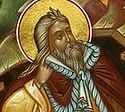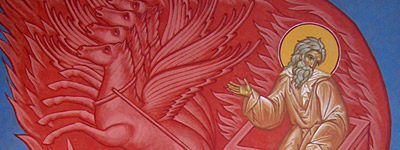

| Previous day | Next day |
| Old Style
July 20
|
Saturday |
New Style
August 2
|
| 8th Week after Pentecost. Tone 6. | No fast.
|
![]() Holy and Glorious Prophet Elias (Elijah) (9th c. b.c.).
Holy and Glorious Prophet Elias (Elijah) (9th c. b.c.).
St. Abramius of Galich, or Chukhloma Lake, disciple of St. Sergius of Radonezh (1375). Uncovering of the relics of Hieromartyr Athanasius, abbot, of Brest-Litovsk (1649). Sts. Savva (1392) and Leontius (late 14th c.), disciples of St. Sergius of Radonezh.
New Martyrs Lydia and soldiers Alexei and Cyril, near Ufa (1928). New Hieromartyrs Archimandrite Tikhon (Krechkov), hieromonks George (Pozharov) and Cosmas (Vyaznikov), and priests John Steblin-Kamensky, Sergius Gortinsky, Theodore Yakovlev, Alexander Arkhangelsky, and George Nikitin, and with them Martyrs Euthymius Grebenshchikov and Peter Vyaznikov, at Voronezh (1930). New Hieromartyr Alexis Znamensky, archpriest, of Vinogradovo (Moscow) (1938).
“Chukhloma” Icon of the Mother of God from Galich (1350).
Righteous Aaron the High Priest, brother of Prophet Moses the God-seer (ca. 1530 b.c.). Sts. Elias, patriarch of Jerusalem (518), and Flavian, patriarch of Antioch (512), confessors. St. Ethelwida, widow of King Alfred the Great (9th c.). Martyr Salome of Jerusalem and Kartli, who suffered under the Persians (13th c.). St. Elias (Chavchavadze) of Georgia (1907). St. Alexis Medvedkov, archpriest, of Ugine, France (1934). Sts. Elias Fondaminsky (1942), Priest Demetrius Klepinine (1944), George Skobtsov (1944), and Nun Maria (Skobtsova) (1945), of Paris.
Repose of Priest Valentine Amphiteatrov of Moscow (1908) and Schemanun Sarah of Borodino (1908).
Thoughts for Each Day of the Year
According to the Daily Church Readings from the Word of God
By St. Theophan the Recluse

Saturday. [Rom. 13:1-10; Matt. 12:30-37]
A good man out of the good treasure of the heart bringeth forth good things: and an evil man out of the evil treasure bringeth forth evil things. What you put in the treasury is what you receive: if you put in gold—you will take away gold; if you put in copper—you will take away copper. Of course, copper can be passed off as gold; but an expert will immediately recognize the forgery. How can we make it so that in our treasury there is only gold; that is, so that in the heart there is only good? The heart by its nature is a treasury of good things; evil came later. Take an anatomical knife of attentiveness and lack of self pity, separate what is unnatural and cut it out. One after the other the evil will leave, while the good will become strengthened and spread; what will remain, at last, will be only good. The question is how to determine what is natural and unnatural. Do not listen to today’s naturalists;[1] they explain everything inside out: what is natural, for them is unnatural; while what is unnatural, for them is natural—they call evil good, and good evil. Look at what the Lord says in the Gospels and the holy apostles in their writings, and according to their instructions determine what is natural. In such a manner, at last, you will gather much good and will bring it forth out of your heart. Pray to the Holy Spirit: “O treasury of good things, entreasure good in my heart!”
[1]By “naturalists” is meant those people who rely on natural science for answers, and deny religion.
Articles
 The Holy Prophet EliasA man who saw God, a wonderworker and zealot for faith in God, Elias was of the tribe of Aaron, from the city of Tishba, whence he was known as "the Tishbite." |
 Holy Prophet Elias |
 Sermon on the Feast of the Holy Prophet EliasArchimandrite Ilya (Reyzmir)Great was the faithfulness of the Prophet Elias to the Lord, and great was the power of his prayer. |
 The Chukhloma (Galich) Icon of the Mother of GodThis Icon of the Mother of God appeared to Avraam of Galich, a disciple of St. Sergius of Radonezh, in the year 1350. |
 Righteous AaronThe Righteous Aaron (1445 B.C.) was the first Old Testament High Priest. |











